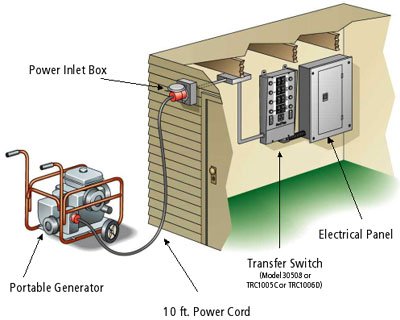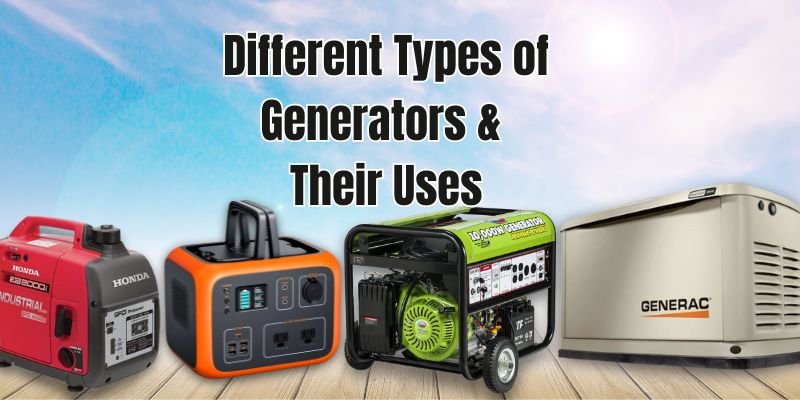Disclosure: This post contains affiliate links and I will be compensated if you make a purchase after clicking through my links. Learn More
A transfer switch for a generator is an important device. It connects your generator to your home’s electrical system.
This switch plays a vital role in ensuring a seamless power supply during outages. Imagine a storm hits, cutting off your electricity. Without a transfer switch, connecting your generator can be risky and confusing. This device makes the process safe and automatic.
It prevents dangerous back-feeding of power, which can harm utility workers and damage your appliances. Using a transfer switch also ensures that your generator powers only essential circuits, keeping your home running smoothly. In this blog, we’ll explore what a transfer switch is, how it works, and why it’s an essential component for anyone using a generator. Understanding this will help you make informed decisions for your home’s safety and efficiency.
Introduction To Transfer Switches
Having a generator is great, but understanding how to use it efficiently is crucial. One essential component in this setup is the transfer switch. If you’ve ever wondered how to seamlessly switch from grid power to generator power, you’re in the right place. Let’s dive into the introduction to transfer switches.
Purpose Of Transfer Switches
Transfer switches are like traffic controllers for your electricity. They ensure that your power supply transitions smoothly from the utility grid to your generator. This prevents any overlap or interruption in power.
Imagine it like this: you’re at home, and suddenly the power goes out. Instead of fumbling around in the dark trying to switch to generator power manually, a transfer switch does it for you automatically. This means you can keep doing what you were doing without a hitch.
Importance For Generators
Why is a transfer switch so important for generators? First, it keeps you safe. Without a transfer switch, there’s a risk of backfeeding. This can be dangerous for utility workers fixing the lines and can also damage your appliances.
Secondly, it adds convenience. Imagine the peace of mind knowing that your generator will kick in seamlessly when needed. No manual work required.
Lastly, it ensures your generator is used efficiently. The transfer switch allows your generator to power only the circuits you need, avoiding unnecessary load and prolonging the lifespan of your generator.
Have you ever experienced a power outage and found the transition frustrating? A transfer switch could be the solution you’ve been looking for. It’s a small investment for a huge payoff in convenience and safety.
Types Of Transfer Switches
Transfer switches are essential for connecting a generator to your home’s electrical system. They allow for a seamless transition between the utility power and the generator. Understanding the types of transfer switches helps in making an informed choice. Here, we will explore the two main types of transfer switches: automatic and manual.
Automatic Transfer Switches
Automatic transfer switches (ATS) switch the power source automatically. They detect power outages and activate the generator without human intervention. This ensures continuous power supply during an outage. ATS are ideal for critical systems like hospitals or data centers. They offer convenience and reliability. However, they are more expensive than manual switches.
Manual Transfer Switches
Manual transfer switches require human action to switch power sources. During an outage, you must manually start the generator and switch the power source. They are simpler and less costly than ATS. These switches are suitable for homes or small businesses. They provide control over the power supply. But they need manual operation, which might be inconvenient during emergencies.
How Transfer Switches Work
A transfer switch is essential for safely switching between power sources. It ensures your generator activates without manual intervention. Transfer switches are designed to manage power flow automatically.
Mechanism And Functionality
Transfer switches have two main types: manual and automatic. Manual switches require human intervention to operate. Automatic switches detect power loss and activate the generator. They use sensors to monitor the electrical supply. When power failure occurs, they switch to the generator.
Automatic transfer switches use relays and circuits. These components control the power transfer. The switch ensures no overlap between power sources. This prevents electrical damage and ensures safety.
Power Transfer Process
The power transfer starts with sensing power loss. The transfer switch then signals the generator to start. Once the generator is running, the switch transfers the load. The entire process takes seconds. This quick transition ensures continuous power supply.
When the main power returns, the switch senses it. It then transfers the load back to the main supply. The generator shuts down automatically. This seamless process ensures minimal disruption. Transfer switches are vital for efficient power management.

Benefits Of Using Transfer Switches
Transfer switches for generators offer several benefits that make them essential for any backup power system. They enhance safety, improve convenience, and boost efficiency. These features ensure a reliable and seamless transition during power outages.
Safety Enhancements
Transfer switches prevent dangerous back-feeding. Back-feeding happens when power from the generator flows back into the utility lines. This can pose a serious risk to utility workers. Transfer switches disconnect the home from the utility lines during a power outage. This ensures power only flows to your home from the generator.
They also protect your generator from overloads. This happens when the generator is forced to handle more power than it can manage. Transfer switches control the load, preventing damage and ensuring optimal performance.
Convenience And Efficiency
Transfer switches simplify the process of switching power sources. Manual switching can be time-consuming and confusing. With a transfer switch, the change is automatic and fast. This ensures a seamless transition from utility power to generator power.
They also ensure that critical systems remain operational. This includes heating, cooling, and medical equipment. Keeping these systems running is crucial during a power outage. Transfer switches help maintain normalcy and comfort in your home.
Installation Process
Installing a transfer switch for a generator can be a game-changer for ensuring a seamless power supply during outages. It’s not just about convenience; it’s about safety and efficiency. Let’s break down the installation process step by step so you can tackle it with confidence.
Pre-installation Considerations
Before diving into the installation, there are a few crucial factors to consider. First, check the power requirements of your home. Make sure the transfer switch matches the wattage of your generator.
Next, decide on the type of transfer switch. Manual transfer switches are cheaper but require you to switch the power manually. Automatic ones are more convenient but come at a higher cost.
Lastly, ensure you have all the necessary tools and materials. This includes screwdrivers, wire cutters, and the transfer switch kit itself. Having everything on hand will save you from unnecessary interruptions.
Step-by-step Guide
Ready to get started? Let’s go through the installation process step by step:
- Turn Off the Main Power: Safety first! Turn off the main power supply to your home to avoid any electrical hazards.
- Select a Location: Choose a suitable location for the transfer switch. It should be close to your main electrical panel for easy wiring.
- Mount the Transfer Switch: Use screws to mount the transfer switch securely on the wall. Make sure it’s level and stable.
- Connect the Wires: Follow the wiring diagram provided in the transfer switch kit. Connect the wires from the main electrical panel to the transfer switch.
- Install the Circuit Breaker: Install the circuit breaker for the generator in the main panel. This will allow you to switch between the main power supply and the generator.
- Test the System: Turn the main power back on and test the transfer switch. Make sure it switches power seamlessly between the main supply and the generator.
And there you have it! Installing a transfer switch might seem daunting, but breaking it down into these manageable steps can make the process straightforward.
Maintenance Tips
Keeping your transfer switch for a generator in top condition ensures reliability. Regular maintenance helps prevent unexpected failures. Below are some crucial maintenance tips to follow.
Routine Inspections
Check your transfer switch at least once a month. Look for any signs of wear or damage. Ensure all connections are tight and secure. Verify the cleanliness of the switch. Dust and dirt can affect performance. Listen for unusual sounds during operation. Early detection of problems can save time and money.
Troubleshooting Common Issues
Identify and address common issues quickly. If the switch does not transfer power, check the fuses. Replace blown fuses immediately. If the switch operates intermittently, inspect the wiring. Loose or damaged wires need fixing. Ensure the generator and transfer switch are compatible. Incompatibility can lead to malfunction. Keep a record of any issues and repairs. This helps in future troubleshooting.
Choosing The Right Transfer Switch
A transfer switch for a generator ensures a safe and seamless power transfer during outages. It automatically switches the power source from the grid to the generator. This device is crucial for maintaining continuous electricity in homes and businesses.
Choosing the right transfer switch is crucial for ensuring your generator operates safely and efficiently. A transfer switch seamlessly transfers the power load from the utility grid to your generator during an outage. But with so many options available, how do you choose the right one? Let’s break it down.
Factors To Consider
When selecting a transfer switch, several factors come into play.
Firstly, power requirements. Determine the wattage your generator can handle and the power needs of your home or business. A switch that’s too small won’t handle the load, while one that’s too large can be unnecessarily expensive.
Secondly, consider manual vs. automatic. Manual switches require you to physically toggle the switch during an outage. Automatic switches, on the other hand, detect power loss and switch over automatically. If convenience is key, automatic is the way to go.
Thirdly, think about installation. Some transfer switches are easier to install than others. If you’re not particularly handy, you might want a model that offers straightforward installation or consider hiring a professional.
Lastly, don’t forget about compatibility. Ensure the switch you choose is compatible with your generator model. Check the manufacturer’s specifications and recommendations.
Top Brands And Models
Several brands stand out in the transfer switch market, known for their reliability and performance.
Generac is a popular choice. Their automatic transfer switches are highly rated and compatible with their extensive range of generators. Models like the Generac 200-Amp RXSC200A3 are well-regarded for residential use.
Reliance Controls offers durable and user-friendly manual transfer switches. The Reliance Controls 31410CRK is a top pick, known for its straightforward installation and robust construction.
Eaton is another trusted brand. Their CHGEN3060 model is praised for its excellent build quality and reliable performance.
Don’t just take our word for it. Do you have a favorite brand or model that has worked well for you? Share your experiences in the comments below. Your insights could help others make an informed decision.
Choosing the right transfer switch doesn’t have to be daunting. By considering your power requirements, the type of switch, ease of installation, and compatibility, you can find the perfect match for your generator. Happy selecting!

Cost And Budgeting
Understanding the cost and budgeting for a transfer switch for a generator is crucial. It helps you plan and avoid unexpected expenses. This section breaks down the initial investment and potential long-term savings.
Initial Investment
The initial investment for a transfer switch can vary. Prices depend on the type and capacity of the switch. Basic models start around $200. Advanced models can exceed $1,000. Professional installation adds to the cost. Installation fees range from $200 to $500. Ensure you budget for both the switch and installation.
Long-term Savings
Investing in a transfer switch can lead to long-term savings. It ensures your generator runs efficiently. This reduces fuel costs over time. It also protects your electrical appliances. Fewer repairs and replacements mean lower maintenance costs. A transfer switch can also extend the life of your generator. This adds to your savings.

Frequently Asked Questions
Do You Need A Transfer Switch For A Generator?
Yes, you need a transfer switch for a generator. It ensures safe and efficient power transfer, preventing backfeeding and protecting your home.
Is It Illegal To Run A Generator Without A Transfer Switch?
Running a generator without a transfer switch is not illegal, but it is highly unsafe. Always use a transfer switch for safety.
Do You Have To Turn Off Your Main Breaker When Using A Generator Transfer Switch?
Yes, you must turn off your main breaker when using a generator transfer switch. This prevents backfeeding and ensures safety.
How Much Does It Cost To Install A Transfer Switch For A Generator?
The cost to install a transfer switch for a generator typically ranges from $500 to $1,500. Factors include switch type and labor.
Final Words
A transfer switch for a generator is essential for safety. It prevents backfeeding and protects your home. This device ensures you have power during outages. It’s simple to use and highly effective. Investing in a transfer switch brings peace of mind.
Your appliances and devices stay powered. Understanding its importance helps you make informed choices. With a transfer switch, you are always prepared. Stay safe and powered up.


